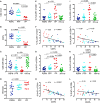Increased Regulatory T-Cell Activity and Enhanced T-Cell Homeostatic Signaling in Slow Progressing HIV-infected Children
- PMID: 30809229
- PMCID: PMC6379343
- DOI: 10.3389/fimmu.2019.00213
Increased Regulatory T-Cell Activity and Enhanced T-Cell Homeostatic Signaling in Slow Progressing HIV-infected Children
Abstract
Pediatric slow progressors (PSP) are rare ART-naïve, HIV-infected children who maintain high CD4 T-cell counts and low immune activation despite persistently high viral loads. Using a well-defined cohort of PSP, we investigated the role of regulatory T-cells (TREG) and of IL-7 homeostatic signaling in maintaining normal-for-age CD4 counts in these individuals. Compared to children with progressive disease, PSP had greater absolute numbers of TREG, skewed toward functionally suppressive phenotypes. As with immune activation, overall T-cell proliferation was lower in PSP, but was uniquely higher in central memory TREG (CM TREG), indicating active engagement of this subset. Furthermore, PSP secreted higher levels of the immunosuppressive cytokine IL-10 than children who progressed. The frequency of suppressive TREG, CM TREG proliferation, and IL-10 production were all lower in PSP who go on to progress at a later time-point, supporting the importance of an active TREG response in preventing disease progression. In addition, we find that IL-7 homeostatic signaling is enhanced in PSP, both through preserved surface IL-7receptor (CD127) expression on central memory T-cells and increased plasma levels of soluble IL-7receptor, which enhances the bioactivity of IL-7. Combined analysis, using a LASSO modeling approach, indicates that both TREG activity and homeostatic T-cell signaling make independent contributions to the preservation of CD4 T-cells in HIV-infected children. Together, these data demonstrate that maintenance of normal-for-age CD4 counts in PSP is an active process, which requires both suppression of immune activation through functional TREG, and enhanced T-cell homeostatic signaling.
Keywords: homeostatic signaling; IL-10; IL-7; immune activation (IA); immune regulation; pediatric HIV-infection; pediatric slow progression; regulatory T cells (Treg).
Figures




Similar articles
-
Delineation of Homeostatic Immune Signatures Defining Viremic Non-progression in HIV-1 Infection.Front Immunol. 2020 Mar 5;11:182. doi: 10.3389/fimmu.2020.00182. eCollection 2020. Front Immunol. 2020. PMID: 32194543 Free PMC article.
-
Immune activation, apoptosis, and Treg activity are associated with persistently reduced CD4+ T-cell counts during antiretroviral therapy.AIDS. 2010 Aug 24;24(13):1991-2000. doi: 10.1097/QAD.0b013e32833c93ce. AIDS. 2010. PMID: 20651586
-
Severe immune dysregulation affects CD4⁺CD25(hi)FoxP3⁺ regulatory T cells in HIV-infected patients with low-level CD4 T-cell repopulation despite suppressive highly active antiretroviral therapy.J Infect Dis. 2012 May 15;205(10):1501-9. doi: 10.1093/infdis/jis230. Epub 2012 Mar 28. J Infect Dis. 2012. PMID: 22457273
-
Blocking Formation of the Stable HIV Reservoir: A New Perspective for HIV-1 Cure.Front Immunol. 2019 Aug 22;10:1966. doi: 10.3389/fimmu.2019.01966. eCollection 2019. Front Immunol. 2019. PMID: 31507594 Free PMC article. Review.
-
Thymic function in HIV-infection.Dan Med J. 2013 Apr;60(4):B4622. Dan Med J. 2013. PMID: 23651726 Review.
Cited by
-
Challenges and Opportunities of Therapies Targeting Early Life Immunity for Pediatric HIV Cure.Front Immunol. 2022 Jul 13;13:885272. doi: 10.3389/fimmu.2022.885272. eCollection 2022. Front Immunol. 2022. PMID: 35911681 Free PMC article. Review.
-
Differences in inducibility of the latent HIV reservoir in perinatal and adult infection.JCI Insight. 2020 Feb 27;5(4):e134105. doi: 10.1172/jci.insight.134105. JCI Insight. 2020. PMID: 31999647 Free PMC article.
-
Highly dampened HIV-specific cytolytic effector T cell responses define viremic non-progression.Immunobiology. 2022 Jul;227(4):152234. doi: 10.1016/j.imbio.2022.152234. Epub 2022 Jun 2. Immunobiology. 2022. PMID: 35671626 Free PMC article.
-
Asymptomatic and Mild SARS-CoV-2 Infections Elicit Lower Immune Activation and Higher Specific Neutralizing Antibodies in Children Than in Adults.Front Immunol. 2021 Sep 30;12:741796. doi: 10.3389/fimmu.2021.741796. eCollection 2021. Front Immunol. 2021. PMID: 34659235 Free PMC article.
-
Distinct Immunoglobulin Fc Glycosylation Patterns Are Associated with Disease Nonprogression and Broadly Neutralizing Antibody Responses in Children with HIV Infection.mSphere. 2020 Dec 23;5(6):e00880-20. doi: 10.1128/mSphere.00880-20. mSphere. 2020. PMID: 33361123 Free PMC article.
References
-
- Blanche S, Newell ML, Mayaux MJ, Dunn DT, Teglas JP, Rouzioux C, et al. . Morbidity and mortality in European children vertically infected by HIV-1. The french pediatric HIV infection study group and european collaborative study. J Acquir Immune Defic Syndr Hum Retrovirol. (1997) 14:442–50 - PubMed
-
- Ananworanich J, Apornpong T, Kosalaraksa P, Jaimulwong T, Hansudewechakul R, Pancharoen C, et al. . Characteristics of lymphocyte subsets in HIV-infected, long-term nonprogressor, and healthy Asian children through 12 years of age. J Allergy Clin Immunol. (2010) 126:1294–1301 e1210. 10.1016/j.jaci.2010.09.038 - DOI - PMC - PubMed
Publication types
MeSH terms
Substances
Grants and funding
LinkOut - more resources
Full Text Sources
Medical
Research Materials
Miscellaneous

